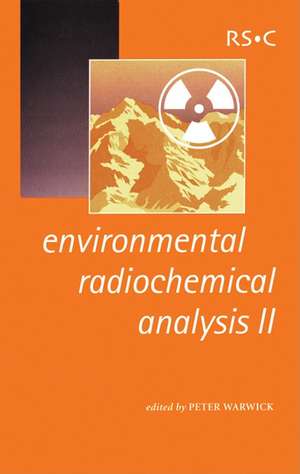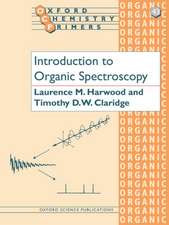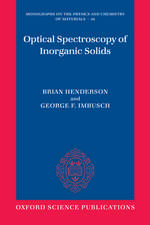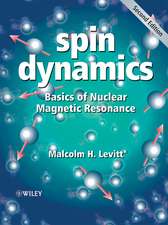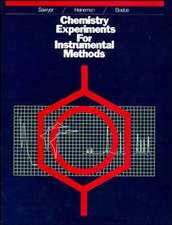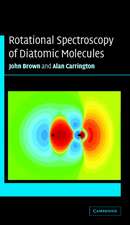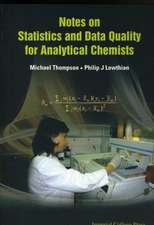Environmental Radiochemical Analysis II: Rsc: Special Publication, cartea 291
Autor Royal Society of Chemistry Editat de Peter Warwicken Limba Engleză Hardback – 31 mai 2003
Environmental Radiochemical Analysis II brings together comprehensive, up-to-date information from international experts in the field. Coverage includes information on new methods of radionuclide analyses, developments and improvements in existing methods, method comparisons, gamma detector performance and new software products, method uncertainty, underground laboratory facilities, method QA and QC, field studies covering colloid work, in-situ injection into rock strata and sampling of reduced waters for actinide assay. This stimulating, authoritative text makes essential reading for practising radioanalysts and provides valuable information for researchers and professionals in academia and industry.
Din seria Special Publication
-
 Preț: 119.56 lei
Preț: 119.56 lei - 14%
 Preț: 930.39 lei
Preț: 930.39 lei - 14%
 Preț: 848.24 lei
Preț: 848.24 lei - 14%
 Preț: 772.72 lei
Preț: 772.72 lei - 14%
 Preț: 929.22 lei
Preț: 929.22 lei - 14%
 Preț: 939.67 lei
Preț: 939.67 lei - 14%
 Preț: 782.17 lei
Preț: 782.17 lei - 14%
 Preț: 1062.13 lei
Preț: 1062.13 lei - 14%
 Preț: 934.04 lei
Preț: 934.04 lei - 11%
 Preț: 654.19 lei
Preț: 654.19 lei - 14%
 Preț: 832.20 lei
Preț: 832.20 lei - 14%
 Preț: 853.71 lei
Preț: 853.71 lei - 14%
 Preț: 940.46 lei
Preț: 940.46 lei - 11%
 Preț: 644.94 lei
Preț: 644.94 lei - 11%
 Preț: 648.03 lei
Preț: 648.03 lei - 14%
 Preț: 936.01 lei
Preț: 936.01 lei - 14%
 Preț: 932.36 lei
Preț: 932.36 lei - 14%
 Preț: 780.35 lei
Preț: 780.35 lei - 14%
 Preț: 782.83 lei
Preț: 782.83 lei - 11%
 Preț: 646.49 lei
Preț: 646.49 lei - 14%
 Preț: 775.53 lei
Preț: 775.53 lei - 14%
 Preț: 923.94 lei
Preț: 923.94 lei - 14%
 Preț: 790.28 lei
Preț: 790.28 lei - 14%
 Preț: 784.15 lei
Preț: 784.15 lei - 27%
 Preț: 2137.96 lei
Preț: 2137.96 lei - 11%
 Preț: 689.47 lei
Preț: 689.47 lei - 14%
 Preț: 778.71 lei
Preț: 778.71 lei - 14%
 Preț: 782.31 lei
Preț: 782.31 lei - 14%
 Preț: 944.44 lei
Preț: 944.44 lei - 11%
 Preț: 611.33 lei
Preț: 611.33 lei - 14%
 Preț: 776.37 lei
Preț: 776.37 lei - 14%
 Preț: 922.77 lei
Preț: 922.77 lei - 14%
 Preț: 778.02 lei
Preț: 778.02 lei - 11%
 Preț: 583.29 lei
Preț: 583.29 lei - 11%
 Preț: 653.17 lei
Preț: 653.17 lei - 5%
 Preț: 862.02 lei
Preț: 862.02 lei - 14%
 Preț: 773.13 lei
Preț: 773.13 lei - 14%
 Preț: 859.18 lei
Preț: 859.18 lei - 11%
 Preț: 657.77 lei
Preț: 657.77 lei - 14%
 Preț: 948.75 lei
Preț: 948.75 lei - 14%
 Preț: 786.15 lei
Preț: 786.15 lei - 14%
 Preț: 942.81 lei
Preț: 942.81 lei - 14%
 Preț: 857.37 lei
Preț: 857.37 lei - 14%
 Preț: 797.79 lei
Preț: 797.79 lei - 14%
 Preț: 960.02 lei
Preț: 960.02 lei - 14%
 Preț: 893.30 lei
Preț: 893.30 lei - 11%
 Preț: 681.43 lei
Preț: 681.43 lei - 14%
 Preț: 798.03 lei
Preț: 798.03 lei
Preț: 858.10 lei
Preț vechi: 997.79 lei
-14% Nou
Puncte Express: 1287
Preț estimativ în valută:
164.22€ • 169.65$ • 136.67£
164.22€ • 169.65$ • 136.67£
Carte tipărită la comandă
Livrare economică 25 martie-08 aprilie
Preluare comenzi: 021 569.72.76
Specificații
ISBN-13: 9780854046188
ISBN-10: 0854046186
Pagini: 432
Ilustrații: 1
Dimensiuni: 156 x 234 x 24 mm
Greutate: 0.78 kg
Editura: Royal Society Of Chemistry
Seria Special Publication
Locul publicării:United Kingdom
ISBN-10: 0854046186
Pagini: 432
Ilustrații: 1
Dimensiuni: 156 x 234 x 24 mm
Greutate: 0.78 kg
Editura: Royal Society Of Chemistry
Seria Special Publication
Locul publicării:United Kingdom
Cuprins
Development of an In-Vitro Procedure to Measure the Availability of Soil-Associated Radionuclides for Uptake After Inadvertent Ingestion by Humans; Separation of Iron-55/59 From Fisson and Activation Products Using Di Isobutylketone-Based Extraction Chromatographic Materials; Synthesis of a Novel Ion Exchanger, Zirconium Vanadate, For Immobilising 134,137Cs Radionuclides; Investigation of a Method for Measuring Radon in Irish Domestic Groundwater Supplies; A comparison of Three Methodologies for the Determination of Gross Alpha Activity in Water Samples; Efficiency and Resolution of Germanium Detectors as a Function of Energy and Incident Geometry; New Method for Determination of Translutonium Isotopes by Using a PM-143 Tracer; Ultra Low-Background Gamma Spectrometry for the Monitoring of Environmental Neutrons; Estimation of Uncertainty in Radiochemical Analysis from Sub-Sampling Solid Matrices; A Rapid Determination of RA-226 and RA-224 Using Extraction Chromatograph; Construction of an Uncertainty Budget for Alpha Spectrometry: A Case Study (The Determination of Uranium Isotopic Activity Levels in Vegetation Samples Using Extraction Chromatography); Spatial and Temporal Variation of Tritium Activities in Coastal Marine Sediments of the Severn Estuary (UK); High Precision PU Isotope Ratio Measurements Using Multi-Collector ICP-MS; Measurement of Gross Alpha and Gross Beta Activity in Sediment: An Analysts' Intercomparison; The Radiological Significance of Foods Collected from the Wild; Natural Radionuclides Measurements in Drinking Water by Liquid Scintillation Counting. Methods and Results; Po Concentrations in UK Seafood; A Study of Colloids in the Near-Field Waters at the Low-Level Waste Repository Site at Drigg; Low Level Liquid Scintillation Counting in a Deep Underground Laboratory: Background Reduction Aspects; Complete Dissolution of Soil Samples by Fusion; LSC: From the Routine Counter to the Real Spectrometer; Simultaneous Determination of Long-Lived Radionuclides in Environmental Samples; Analysis of Am, Pu and Th in Large Volume Water Samples in the Presence of High Concentrations of Iron; In-Situ Radionuclide Retardation in Groundwater Conducting Systems - Overview of the Research Carried out at Nagra's Grimsel Test Site, Central Switzerland; Elution Behaviour of Technetium and Rehenium Through a Tc-Selective Chromatographic Resin Column; The Use of Fucus Vesiculosus to Monitor the Transport of 1291 in The English Channel; Determination of 237Np by Neutron Activation Analysis and Alpha Sepctrometry; Man-Made Radionuclides in Age-Dated Sediment Cores from the Black Sea; Determination of Plutonium in the Air by Isotopic Dilution ICP-MS After TNOA Extraction Chromatographic Separation; Simple Method for C-14 Analysis in Organic Material and its Distribution in Forest and Cultivated Field; F-Labelling of Humic Substances; Chemicals and Radiological Characterisation of Santos Estuary Sediments; Thermochromatographic Studies on the Separation of Plutonium from Soil Samples; Partitioning of Plutonium Isotopes in Lake Bottom Sediments; Radioanalytical Method for the Determination of Sr In Soil Samples by Yttrium Solvent Extraction and Cerenkov Counting; Investigation of Inorganic Contaminants in Packaging Made From Recycled Paper and Board; Equilibrium Factor F and Effective Dose Equivalent with Solid State Nuclear Track Detectors; Biological Monitoring of Radioactivity and Metal Pollution in Edible Eggs of Liometopum apiculatum (Ants) From a Radioactive Waste Site in Central Mexico; Preparation of Environmental Samples for Radioanalytical Assay: An Overview; Comparative Investigations on Hydrophilicity and Mobility of Humic Substances Using Radiolabelling Techniques; Determination of Gross Alpha in Drinking Water and Nuclear Waste Water Using Actinide Resin ™ and LSC; Chromium Speciation in Acidic Solutions Using Radiochromtographic Methods; Influence of Geochemical Parameters on the Mobility of Metal-Humate Complexes; Ultra Sensitive Measurements of Gamma-Ray Emitting Radionuclides Using HPGE-Detectors in the Underground Laboratory Hades; Sedimentation Rates and Metals in Sediments from the Reservoir Rio Grande - São Paulo/Brazil; Operational Speciation of Ra and U-Isotopes in Sediments Affected by Non-Nuclear Industry Wastes; Radiochronology of Sediment Cores Collected in an Estuary Strongly Affected by Fertilizer Plants Releases; Chemical Fractionation of Iodine-129 and Cesium-137 in Chernobyl Contaminated Soil and Irish Sea Sediment; Subject Index
Descriere
This stimulating, authoritative text makes essential reading for practising radioanalysts and provides valuable information for researchers in academia and industry.
